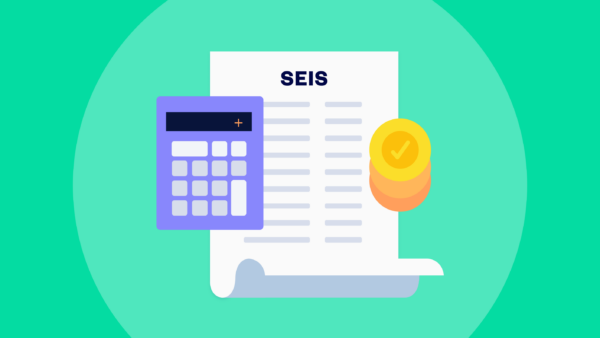NEW in SeedLegals for Investors: more functionality, visibility and efficiency
You now have more control to lead your deals and see what’s happening at each stage. See the latest updates in the SeedL...


Get in at the ground floor of the next tech unicorn, cash in big at exit. That’s the ideal scenario. But investing early comes with bigger risks. You don’t know if a company will actually take off or if you’ll end up losing cash.
Luckily, the UK government sweetens the deal for investors who take a chance on early-stage companies to get them up and running. HMRC’s Seed Enterprise Investment Scheme (SEIS) offsets some of the unknowns by giving investors generous tax relief.
Speed up negotiations and cut down on admin with the help of our experts.
Book a demo
SEIS is one of the UK government’s venture capital schemes. It offers tax relief to private investors who put money into early-stage startups.
These startups innovate, create jobs and grow the economy – all things the UK government wants to promote. But they carry more risk than traditional investments like property and the stock market. So as a reward for taking a bigger risk, the UK government offers tax incentives to help bring this risk factor down.
Because SEIS is designed to support small, seed-stage businesses – aka, the very riskiest ones – it offers some of the most generous perks to investors of all the venture capital schemes.
The great news is you can claim tax relief from multiple venture capital schemes in the same year, so, for example, you can claim both SEIS and EIS tax relief at the same time.

Under SEIS, you get back 50% of the amount you invest as a reduction in your Income Tax bill.
For example, say you invested £10,000 in an SEIS-eligible company. When you file your tax return, you list the details of your SEIS-qualifying investment to reduce your Income Tax bill by £5,000.
Normally when you come to sell your shares, you pay Capital Gains Tax on the profit you make. But with SEIS, you get to keep it all. You pay 0% CGT tax no matter how small or large the eventual exit is.
You can offset 50% of Capital Gains Tax charges when you reinvest taxable profit made from a non SEIS-eligible company into an SEIS-eligible company.
If you haven’t made a profit when you come to sell your shares, you can set that loss against your Income Tax bill. See an example of how that works on this gov.uk page.
Jonny SeamanThe scheme is powerful in its own right and loss relief is the cherry on the cake when it comes to derisking. It means that if your investment doesn’t work out, you can recoup a significant chunk of the lost money.
Investor Partnerships Manager,
SEIS shares aren’t subject to Inheritance Tax, so long as they have been held for 2 years.


Jamie WilliamsAs the calculations show, there is significant benefit to an investor when a gain is made on an SEIS investment, but the scheme also minimises risk. Your total exposure as an additional rate taxpayer is just 27.5% on an SEIS investment.
Tax Director,
There are various rules for both companies and investors. These rules exist to protect the spirit of the scheme – to reward investors for taking a risk on a small, newly established company that’s otherwise unconnected to their own financial interests.
The first thing is to benefit from SEIS tax relief, you have to be a UK taxpayer.
There are several rules in place to keep the scheme working as intended. Essentially:
See SEIS rules for investors for a full explanation of the rules.

SEIS rewards investors for supporting small, seed-stage startups.
To be eligible for SEIS, companies must:
For full details, see our article for startups on the SEIS company criteria.
You can claim SEIS tax relief up to five years from the 31 January that follows the tax year in which you made the investment. It’s 31 January because that’s the deadline for Self Assessment tax returns.
If you don’t use all of your SEIS allowance (£200,000 per year), you can’t carry forward the SEIS limit to the next year.
But you can carry back SEIS tax relief to the previous year, if you haven’t already invested the maximum allowed under the scheme in that year.
Jamie WilliamsThe timing of your investment is key. Funds have to be invested before the shares are issued or on the same day. If funds aren’t received by the date the shares are issued, this is a disqualifying event for the scheme and you’ll lose the relief.
Funds can be invested before the share issue, but the gap should be minimal (unless you’re investing via an advanced subscription agreement). If the gap is too long, you risk the funds being deemed a loan which is another disqualifying event, meaning you’ll lose the relief.
Tax Director,
So, you’ve found SEIS-eligible companies, checked they have SEIS Advance Assurance, completed the negotiations, and invested.
What happens next? How do you actually get the tax relief you were promised?
There are rules about when the company can complete the compliance steps. HMRC accepts compliance statements after the company has carried out their qualifying business activity for at least four months or spent at least 70% of the SEIS amount raised.
Typically, HMRC reviews the company’s compliance application in about 15 to 45 working days.
To approve SEIS-qualifying status, HMRC sends the investee company two documents:
As an investor, you claim your SEIS tax relief when you fill in your annual Self Assessment tax return. On the Additional Information page, under ‘Other tax reliefs’, enter the total you’ve invested in companies under SEIS (and any other Venture Capital Scheme you’re applying for).
If things don’t go as planned and you make a loss on your investment, you can claim loss relief. Loss relief allows you to offset a loss, minus any income tax relief you’ve already had from HMRC, against your income.
If you’re claiming the loss for the current tax year, you can contact HMRC to request a change to your PAYE tax code or make an adjustment to your Self Assessment tax payments.
If you’re claiming the loss for the previous tax year, make the claim on your Self Assessment tax return. See full details on how to claim SEIS/EIS loss relief at the gov.uk website.
When the company isn’t profitable and isn’t able to raise more, founders broadly have three choices: to sell, to go into zombie mode (reduce burn to zero, meaning no productivity or revenue) or to shut down. The route they take affects whether you can claim loss relief.
Is loss relief available?
Conditions:
Is loss relief available?
Is loss relief available?
Conditions:
Take a look at this video to hear from SeedLegals co-founder and CEO, Anthony Rose, how each of these three strategies affects your loss relief as an SEIS/EIS investor and when you’ll be able to claim.
If you don’t want to manage the investment process yourself, you can still benefit from SEIS tax relief by investing in an SEIS fund.
SEIS funds pool money from investors to spread across a portfolio of SEIS-eligible companies. The fund is responsible for due diligence and making sure that the companies in the portfolio qualify for SEIS.
Jonny SeamanChoosing between investing in an SEIS fund or directly as an angel investor involves trade-offs. SEIS funds offer diversification and professional management, while operating as an angel means you get more control over your investment and the full benefit of any potential return.
Investor Partnerships Manager,
Manage your deals on invest.seedlegals.com, the dedicated portal for angels and funds who’ve invested in startup companies.
Log in to see all your deals, view the total value of your investments, model exit scenarios, send out Term Sheets, negotiate directly on the document through comments, store your SEIS3 and share certificates.
To find out more about how we can help you streamline and manage your deals, choose a time for a friendly call with our investor team.
Fill in the form so we can match you to the right specialist.






